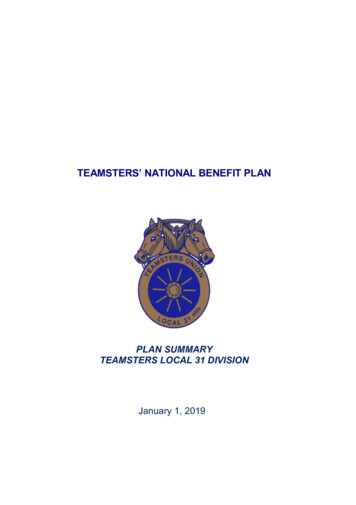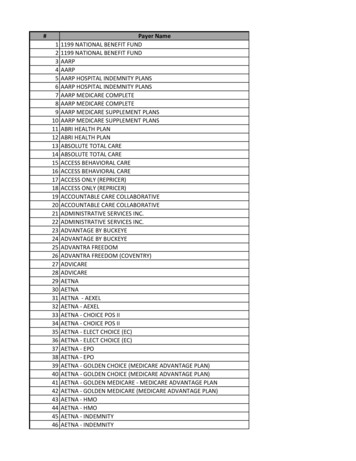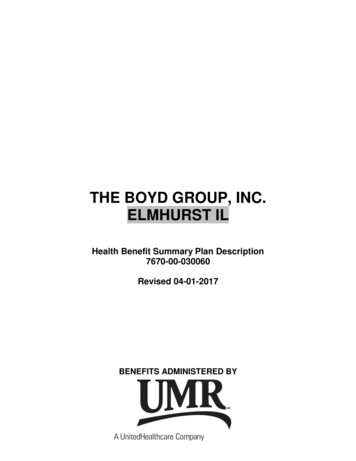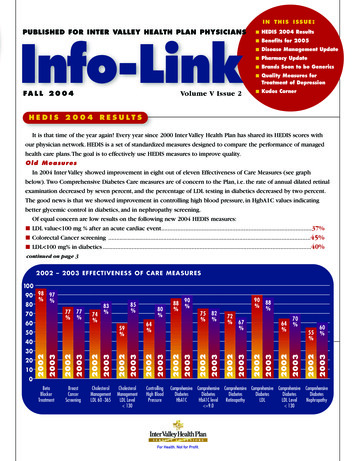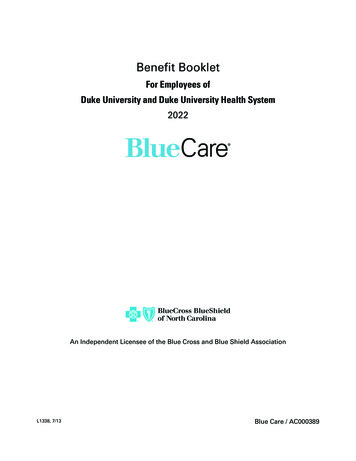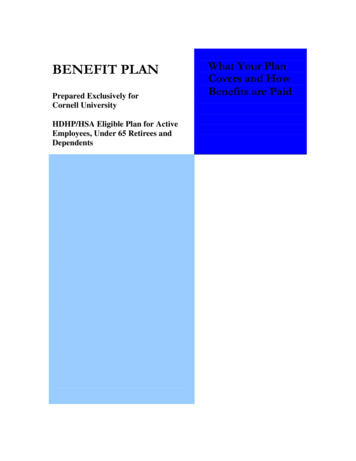
Transcription
BENEFIT PLANPrepared Exclusively forCornell UniversityHDHP/HSA Eligible Plan for ActiveEmployees, Under 65 Retirees andDependentsWhat Your PlanCovers and HowBenefits are Paid
Table of ContentsPreface .1Important Information Regarding Availability ofCoverageCoverage for You and Your Dependents.2Health Expense Coverage .2Treatment Outcomes of Covered ServicesWhen Your Coverage Begins .3Who Can Be Covered .3EmployeesEligible ClassesDetermining if You Are in an Eligible ClassObtaining Coverage for DependentsHow and When to Enroll.5Initial Enrollment in the PlanLate EnrollmentAnnual EnrollmentSpecial Enrollment PeriodsWhen Your Coverage Begins.7Your Effective Date of CoverageYour Dependent’s Effective Date of CoverageRetired EmployeesHow Your Medical Plan Works .9Common Terms.9Your HDHP/HSA Aetna Choice POS II MedicalPlan .9About Your HDHP/HSA Aetna Choice POS IIMedical Plan .10Availability of ProvidersHow Your Aetna Choice POS II Medical PlanWorks.11Understanding PrecertificationServices and Supplies Which RequirePrecertification:Emergency and Urgent Care.14In Case of a Medical EmergencyCoverage for Emergency Medical ConditionsIn Case of an Urgent ConditionCoverage for an Urgent ConditionNon-Urgent CareFollow-Up Care After Treatment of anEmergency or Urgent Medical ConditionRequirements For Coverage .17What The Plan Covers .18Aetna Choice POS II Medical Plan .18Wellness.18Routine Physical ExamsRoutine Cancer ScreeningsFamily Planning ServicesVision Care ServicesLimitationsHearing ExamPhysician Services .20Physician VisitsSurgeryAnestheticsAlternatives to Physician Office VisitsHospital Expenses. 21Room and BoardOther Hospital Services and SuppliesOutpatient Hospital ExpensesCoverage for Emergency Medical ConditionsCoverage for Urgent ConditionsAlternatives to Hospital Stays . 23Outpatient Surgery and Physician SurgicalServicesBirthing CenterHome Health CarePrivate Duty NursingSkilled Nursing FacilityHospice CareOther Covered Health Care Expenses . 27AcupunctureAmbulance ServiceGround AmbulanceAir or Water AmbulanceDiagnostic and Preoperative Testing . 28Diagnostic Complex Imaging ExpensesOutpatient Diagnostic Lab Work andRadiological ServicesOutpatient Preoperative TestingDurable Medical and Surgical Equipment (DME). 29Experimental or Investigational Treatment . 30Pregnancy Related Expenses. 30Prosthetic Devices. 31Short-Term Rehabilitation Therapy Services. 31Cardiac and Pulmonary Rehabilitation BenefitsOutpatient Cognitive Therapy, Physical Therapy,Occupational Therapy and Speech TherapyRehabilitation BenefitsReconstructive or Cosmetic Surgery and Supplies. 33Reconstructive Breast SurgerySpecialized Care. 34ChemotherapyRadiation Therapy BenefitsOutpatient Infusion Therapy BenefitsEnteral Formulas. 35Treatment of Infertility. 35Basic Infertility ExpensesAdvanced Reproductive Technology (ART)BenefitsExclusions and LimitationsSpinal Manipulation Treatment . 36Transplant Services . 36Network of Transplant Specialist FacilitiesObesity Treatment . 38
Alcoholism, Substance Abuse and Mental DisordersGeneral Provisions . 61Type of Coverage . 61Treatment.39Treatment of Mental DisordersPhysical Examinations. 61Alcoholism and Substance AbuseLegal Action . 61Oral and Maxillofacial Treatment (Mouth, Jaws andConfidentiality. 61Additional Provisions . 61Teeth).41Medical Plan Exclusions.43Assignments . 62When Coverage Ends .51Misstatements . 62When Coverage Ends For EmployeesIncontestability . 62Continuation of Coverage .53Subrogation and Right of Reimbursement . 63Worker’s Compensation. 64Continuing Health Care BenefitsHandicapped Dependent ChildrenRecovery of Overpayments . 64COBRA Continuation of Coverage.54Health CoverageContinuing Coverage through COBRAReporting of Claims. 64Who Qualifies for COBRAPayment of Benefits. 65Disability May Increase Maximum ContinuationRecords of Expenses . 65Contacting Aetna. 65to 29 MonthsDetermining Your Contributions ForEffect of Benefits Under Other Plans . 66Continuation CoverageEffect of An Health Maintenance OrganizationWhen You Acquire a Dependent During aPlan (HMO Plan) On CoverageEffect of Prior Coverage - Transferred Business 66Continuation PeriodDiscount Programs . 67When Your COBRA Continuation CoverageEndsDiscount ArrangementsCoordination of Benefits - What Happens WhenIncentives. 67Glossary. 68There is More Than One Health Plan.57Other Plans Not Including Medicare .57Appeal ProcedureWhen You Have Medicare Coverage.60Effect of Medicare.60* Defines the Terms Shown in Bold Type in the Text of This Document.
PrefaceAetna Life Insurance Company (referred to as Aetna) is pleased to provide you with this Booklet. Read this Bookletcarefully. The plan described in this Booklet is a benefit plan of the Employer. These benefits are not insured withAetna or any of its affiliates, but will be paid from the Employer's funds. Aetna and its HMO affiliates will providecertain administrative services under the plan as outlined in the Administrative Services Agreement between Aetnaand the Customer.This Booklet is part of the Contract between Aetna and the Customer. The Contract determines the terms and conditionsof coverage. Aetna agrees with the Customer to provide coverage in accordance with the conditions, rights, andprivileges as set forth in this Booklet. The Customer selects the products and benefit levels under the plan. A personcovered under this plan and their covered dependents are subject to all the conditions and provisions of the Contract.The Booklet describes the rights and obligations of you and Aetna, what the plan covers and how benefits are paid forthat coverage. It is your responsibility to understand the terms and conditions in this Booklet. Your Booklet includes theSchedule of Benefits and any amendments or riders.If you become covered, this Booklet replaces and supersedes all Booklets describing similar coverage that Aetnapreviously issued to you.Customer:Contract Number:Contract Effective Date:Issue Date:Booklet Number:Cornell University397366January 1, 2009May 3, 20109Ronald A. WilliamsChairman, Chief Executive Officer and PresidentAetna Life Insurance Company(A Stock Company)1
Important Information Regarding Availability of CoverageNo services are covered under this Booklet in the absence of payment of current fees.Coverage for You and Your DependentsHealth Expense CoverageBenefits are payable for covered health care expenses that are incurred by you or your covered dependents whilecoverage is in effect. An expense is “incurred” on the day you receive a health care service or supply. This planprovides coverage for the following: Medical PlanCoverage under this plan is non-occupational. Only non-occupational injuries and non-occupational illnesses arecovered. Conditions that are related to pregnancy may be covered under this plan.Refer to the What the Plan Covers section of the Booklet for more information about your coverage.Treatment Outcomes of Covered ServicesAetna is not a provider of health care services and therefore is not responsible for and does not guarantee any resultsor outcomes of the covered health care services and supplies you receive. Providers of health care services, including,hospitals, institutions, facilities or agencies are independent contractors and are neither agents nor employees ofAetna or its affiliates.2
When Your Coverage BeginsWho Can Be CoveredHow and When to EnrollWhen Your Coverage BeginsThroughout this section you will find information on who can be covered under the plan, how to enroll and what todo when there is a change in your life that affects coverage. In this section, “you” means the employee.Who Can Be CoveredEmployeesTo be covered by this plan, the following requirements must be met: You will need to be in an “eligible class,” as defined below; andYou will need to meet the “eligibility date criteria” described below.Eligible ClassesYou are in an eligible class if: You are a retired employee of an employer participating in this plan, and you: Retired before the effective date of this plan and were covered under the prior plan for health care coverageon the day before you retired; or Were covered under this plan or another plan sponsored by your employer on the day before you retired; and Have completed 10 years of benefit eligible service and are age 55 or older.Determining if You Are in an Eligible ClassYou are in an eligible class if:1. A Regular Employees who works at least 20 hours per week for at least 6 months.2. A Member of the Faculty or Academic Staff of the Endowed Colleges who is employed at least one full semester ata time; or3. A Postdoctoral Fellow or visiting fellow without salary in a Statutory Division of CornellDetermining When You Become EligibleYou become eligible for the plan on your eligibility date, which is determined as follows.On the Effective Date of the PlanIf you are in an eligible class on the effective date of this plan, your coverage eligibility date is the effective date of theplan.After the Effective Date of the PlanIf you are hired after the effective date of this plan, your coverage eligibility date is the date you are hired.If you enter an eligible class after the effective date of this plan, your coverage eligibility date is the date you enter theeligible class.3
Obtaining Coverage for DependentsYour dependents can be covered under your plan. You may enroll the following dependents: Your legal spouse; orYour same sex partner who meets the rules set by your employer; andYour dependent children.Aetna will rely upon your employer to determine whether or not a person meets the definition of a dependent forcoverage under the plan. This determination will be conclusive and binding upon all persons for the purposes of thisplan.Coverage for Same Sex PartnerTo be eligible for coverage, you and your same sex partner will need to complete and sign a Declaration of Same SexPartnership. If you have completed and signed a statement of Same Sex Partnership and the statement is acceptable toyour employer, you may cover as your dependent the person who is the same sex partner named in your statement.Imputed Income Assessed on Same Sex PartnersThe value of the health benefits your partner receives is viewed as taxable income based on the Internal RevenueCode. Same-sex partners do not meet the IRS’s definition of a dependent. When an employer provides a benefit tosomeone other than a dependent (as defined by the Internal Revenue Code), the value of the benefit provided mustbe calculated into the gross income of the employee for tax purposes. Faculty and staff who cover a partner shouldbe aware that this may increase their federal and state taxes.The imputed income is the total amount Cornell University contributes toward coverage less the amount Cornellcontributes for employee-only coverage. The value is added into your gross income per pay period. The taximplications vary by individual and you may need to seek the advice of your tax advisor.If you are enrolled in a coverage level other than employee-only, and are adding your partner to your coverage, yourimputed income is calculated on the value of Cornell University’s contribution for employee-only coverage.The cost of coverage for your same-sex partner must be paid on an after-tax basis and will be deducted from yourpaycheck. The cost of coverage is the amount you pay versus the amount the University contributes towards the costof the level of coverage you have (Imputed Income is calculated on the University portion).Coverage for Dependent ChildrenTo be eligible, a dependent child must be: Unmarried; andUnder 19 years of age; orUnder age 25, as long as he or she is a full-time student at an accredited institution of higher education and solelydepends on your support*.*Note: Proof of full-time student status is required each year. This means that the child is enrolled as anundergraduate student with a total course load of least 12 credits or is enrolled as a graduate student with a totalcourse load of at least 9 credits.An eligible dependent child includes: Your biological children;Your stepchildren;Your legally adopted children;4
Any children for whom you are responsible under court order;Your grandchildren in your court-ordered custody; andAny other child who lives with you in a parent-child relationship.Coverage for a handicapped child may be continued past the age limits shown above. See Handicapped DependentChildren for more information.Important ReminderKeep in mind that you cannot receive coverage under the plan as: Both an employee and a dependent; orA dependent of more than one employee.How and When to EnrollInitial Enrollment in the PlanYou will be provided with plan benefit and enrollment information when you first become eligible to enroll. You willneed to enroll in a manner determined by Aetna and your employer. To complete the enrollment process, you willneed to provide all requested information for yourself and your eligible dependents. You will also need to agree tomake required contributions for any contributory coverage. Your employer will determine the amount of your plancontributions, which you will need to agree to before you can enroll. Your employer will advise you of the requiredamount of your contributions and will deduct your contributions from your pay. Remember plan contributions aresubject to change.You will need to enroll within 60 days of your eligibility date. Otherwise, you may be considered a Late Enrollee. Ifyou miss the enrollment period, you will not be able to participate in the plan until the next annual enrollment period,unless you qualify under a Special Enrollment Period, as described below.If you do not enroll for coverage when you first become eligible, but wish to do so later, your employer will provideyou with information on when and how you can enroll.Section 125, the Internal Revenue Code and related regulations which govern certain aspects of the plan's operationprohibit employees from making a change in coverage during the year unless they experience a Qualified Change inFamily Status or a Special Termination Event. Those circumstances are described in the Special Enrollment Periodssection of this Summary of Coverage. Of course, you can always change your coverage election during the annualenrollment period each November. Changes made during the annual enrollment period are effective January 1 of thefollowing year. Our plan is administered in this manner to comply with IRS regulations.Late EnrollmentIf you do not enroll during the Initial Enrollment Period, or a subsequent annual enrollment period, you and youreligible dependents may be considered Late Enrollees and coverage may be deferred until the next annual enrollmentperiod. If, at the time of your initial enrollment, you elect coverage for yourself only and later request coverage foryour eligible dependents, they may be considered Late Enrollees.You must return your completed enrollment form before the end of the next annual enrollment period.However, you and your eligible dependents may not be considered Late Enrollees under the circumstances describedin the “Special Enrollment Periods” section below.5
Annual EnrollmentDuring the annual enrollment period, you will have the opportunity to review your coverage needs for the upcomingyear. During this period, you have the option to change your coverage. The choices you make during this annualenrollment period will become effective January 1.If you do not enroll yourself or a dependent for coverage when you first become eligible, but wish to do so later, youwill need to do so during the next annual enrollment period, unless you qualify under one of the Special EnrollmentPeriods, as described below.Special Enrollment PeriodsYou will not be considered a Late Enrollee if you qualify under a Special Enrollment Period as defined below. If oneof these situations applies, you may enroll before the next annual enrollment period.Loss of Other Health Care CoverageYou or your dependents may qualify for a Special Enrollment Period if: You did not enroll yourself or your dependent when you first became eligible or during any subsequent annualenrollments because, at that time: You or your dependents were covered under other creditable coverage; and You refused coverage and stated, in writing, at the time you refused coverage that the reason was that you oryour dependents had other creditable coverage; andYou or your dependents are no longer eligible for other creditable coverage because of one of the following: The end of your employment; A reduction in your hours of employment (for example, moving from a full-time to part-time position); The ending of the other plan’s coverage; Death; Divorce or legal separation; Employer contributions toward that coverage have ended; COBRA coverage ends; The employer’s decision to stop offering the group health plan to the eligible class to which you belong; Cessation of a dependent’s status as an eligible dependent as such is defined under this Plan; With respect to coverage under Medicaid or an S-CHIP Plan, you or your dependents no longer qualify forsuch coverage; or You or your dependents have reached the lifetime maximum of another Plan for all benefits under that Plan.You will need to enroll yourself or a dependent for coverage: Within 60 days of when other creditable coverage ends;Within 60 days of when coverage under Medicaid or an S-CHIP Plan ends; orWithin 60 days of the date you or your dependents become eligible for Medicaid or S-CHIP premium assistance.Evidence of termination of creditable coverage must be provided to Cornell Benefit Services. If you do not enrollduring this time, you will need to wait until the next annual enrollment period.New DependentsYou and your dependents may qualify for a Special Enrollment Period if: You did not enroll when you were first eligible for coverage; andYou later acquire a dependent, as defined under the plan, through marriage, birth, adoption, or placement foradoption; andYou elect coverage for yourself and your dependent within 60 days of acquiring the dependent.6
Your spouse, same sex partner or child who meets the definition of a dependent under the plan may qualify for aSpecial Enrollment Period if: You did not enroll them when they were first eligible; andYou later elect coverage for them within 60 days of a court order requiring you to provide coverage.You will need to report any new dependents by completing a change form, which is available from your employer.The form must be completed and returned to Cornell Benefit Services within 60 days of the change. If you do notreturn the form within 60 days of the change, you will need to make the changes during the next annual enrollmentperiod.If You Adopt a ChildYour plan will cover a child who is placed for adoption. This means you have taken on the legal obligation for total orpartial support of a child whom you plan to adopt.Your plan will provide coverage for a child who is placed with you for adoption if: The child meets the plan’s definition of an eligible dependent on the date he or she is placed for adoption; andYou request coverage for the child in writing within 60 days of the placement.Proof of placement will need to be presented to Cornell Benefit Services prior to the dependent enrollment.Any coverage limitations for a pre-existing condition will not apply to a child placed with you for adoptionprovided that the placement occurs on or after the effective date of your coverage.When You Receive a Qualified Child Support OrderA Qualified Medical Child Support Order (QMCSO) is a court order requiring a parent to provide health carecoverage to one or more children. Your plan will provide coverage for a child who is covered under a QMCSO, if: The child meets the plan’s definition of an eligible dependent; andYou complete an enrollment form. Child will automatically be enrolled in the event a form is not completed.Coverage for the dependent will become effective on the date of the court order.Under a QMCSO, if you are the non-custodial parent, the custodial parent may file claims for benefits. Benefits forsuch claims will be paid to the custodial parent.When Your Coverage BeginsYour Effective Date of CoverageIf you have met all the eligibility requirements, your coverage takes effect on your eligibility date.If you do not return your completed enrollment information within 60 days of your eligibility date, the rules under theSpecial or Late Enrollment Periods section will apply.Important Notice:You must pay the required contribution in full retroactive to your eligibility date.Your Dependent’s Effective Date of CoverageYour dependent’s coverage takes effect on the same day that your coverage becomes effective, if you have enrolledthem in the plan.7
Note: New dependents need to be reported to Cornell Benefit Services within 60 days because they may affect yourcontributions. If you do not report a new dependent within 60 days of his or her eligibility date, the rules under theSpecial or Late Enrollment Periods section will apply.Retired EmployeesRetirees who do not continue coverage for any reason will not be allowed to re-enroll at a later date.8
How Your Medical Plan WorksCommon TermsAccessing ProvidersPrecertificationIt is important that you have the information and useful resources to help you get the most out of your Aetna medicalplan. This Booklet explains: Definitions you need to know;How to access care, including procedures you need to follow;What expenses for services and supplies are covered and what limits may apply;What expenses for services and supplies are not covered by the plan;How you share the cost of your covered services and supplies; andOther important information such as eligibility, complaints and appeals, termination, continuation of coverage,and general administration of the plan.Important Notes Unless otherwise indicated, “you” refers to you and your covered dependents. You can refer to the Eligibilitysection for a complete definition of ‘you’.Your health plan pays benefits only for services and supplies described in this Booklet as covered expenses thatare medically necessary.This Booklet applies to coverage only and does not restrict your ability to receive health care services that are notor might not be covered benefits under this health plan.Store this Booklet in a safe place for future reference.Common TermsMany terms throughout this Booklet are defined in the Glossary section at the back of this document. Defined termsappear in bolded print. Understanding these terms will also help you understand how your plan works and provideyou with useful information regarding your coverage.Your HDHP/HSA Aetna Choice POS II Medical PlanYour HDHP/HSA Plan is health coverage plus a health savings account (HSA) rolled into one. It includes: A high-deductible health plan that provides health care coverage (the Aetna Choice POS II Medical Plan); andA health savings account to spend or save.You visit your doctor for health care and the Plan will pay for covered services. You may be asked by your doctor topay your share of the cost at the time of your visit or your doctor may bill you afterward. You can use the money inyour HSA to pay for qualified medical expenses or you can pay the expenses out of your pocket and save the moneyin your HSA.Important NoteFor additional information regarding health savings accounts, please access the Cornell University Division of HumanResources website or contact Member Services at 1-877-371-2007.9
About Your Aetna HDHP/HSA Aetna Choice POS II MedicalPlanThis HDHP/HSA Aetna Choice POS II medical plan provides coverage for a wide range of medical expenses for thetreatment of illness or injury. It does not provide benefits for all medical care. The plan also provides coverage forcertain preventive and wellness benefits. With your HDHP/HSA Aetna Choice POS II plan, you can directly accessany physician, hospital or other health care provider (network or out-of-network) for covered services andsupplies under the plan. The plan pays benefits differently when services and supplies are obtained through networkproviders or out-of-network providers.The plan will pay for covered expenses up to the maximum benefits shown in this Booklet. Coverage is subject to allthe terms, policies and procedures outlined in this Booklet. Not all medical expenses are covered under the plan.Exclusions and limitations apply to certain medical services, supplies and expenses. Refer to the What the Plan Covers,Exclusions, Limitations and Schedule of Benefits sections to determine if medical services are covered, excluded or limited.This HDHP/HSA Aetna Choice POS II plan provides access to covered benefits through a network of health careproviders and facilities. These network providers have contracted with Aetna, an affiliate or third party vendor toprovide health care services and supplies to Aetna plan members at a reduced fee called the negotiated charge. ThisHDHP/HSA Aetna Choice POS II plan is designed to lower your out-of-pocket costs when you use networkproviders for covered expenses. Your deductibles, copayments, and coinsurance will generally be lower whenyou use participating network providers and facilities.You also have the choice to access licensed providers, hospitals and facilities outside the network for coveredbenefits. Your out-of-pocket costs will generally be higher. Deductibles, copayments, and coinsurance are usuallyhigher when you utilize out-of-network providers. Out-of-network providers have not agreed to accept thenegotiated charge and may balance bill you for charges over the amount Aetna pays under the plan.Some services and supplies may only be covered through network providers. Refer to the Covered Benefit sections andyour Schedule of Benefits to determine if any services are limited to network coverage only.Your out-of-pocket costs may vary between network and out-of-network benefits. Read your Schedule of Benefitscarefully to understand the cost sharing charges applicable to you.Availability of ProvidersAetna cannot guarantee the availability or continued participation of a particular provider. Either Aetna or anynetwork provider may terminate the provider contract or limit the number of patients accepted in a practice. If thephysician initially selected cannot accept additional patients, you will be notified by the Provider and given anopportunity to make another selection.Ongoing ReviewsAetna conducts ongoing reviews of those services and supplies which are recommended or provided by healthprofessionals to determine whether such services and supplies are covered benefits under this Booklet. If Aetnadetermines that the recommended services or supplies are not covered benefits, you will be notified. You may appealsuch determinations by contacting Aetna to seek a review of the determination. Please refer to the ClaimProcedures/Complaints and Appeals section of this Booklet.To better understand the choices that you have with your HDHP/HSA Aetna Choice POS II plan, please carefullyreview the following information.10 pa
Aetna Life Insurance Company (referred to as Aetna) is pleased to provide you with this Booklet.Read this Booklet carefully. The plan described in this Booklet is a benefit plan of the Employer.These benefits are not insured with Aetna or any of its affiliates, but will be paid from the Employer's funds.Aetna and its HMO affiliates will provide .
